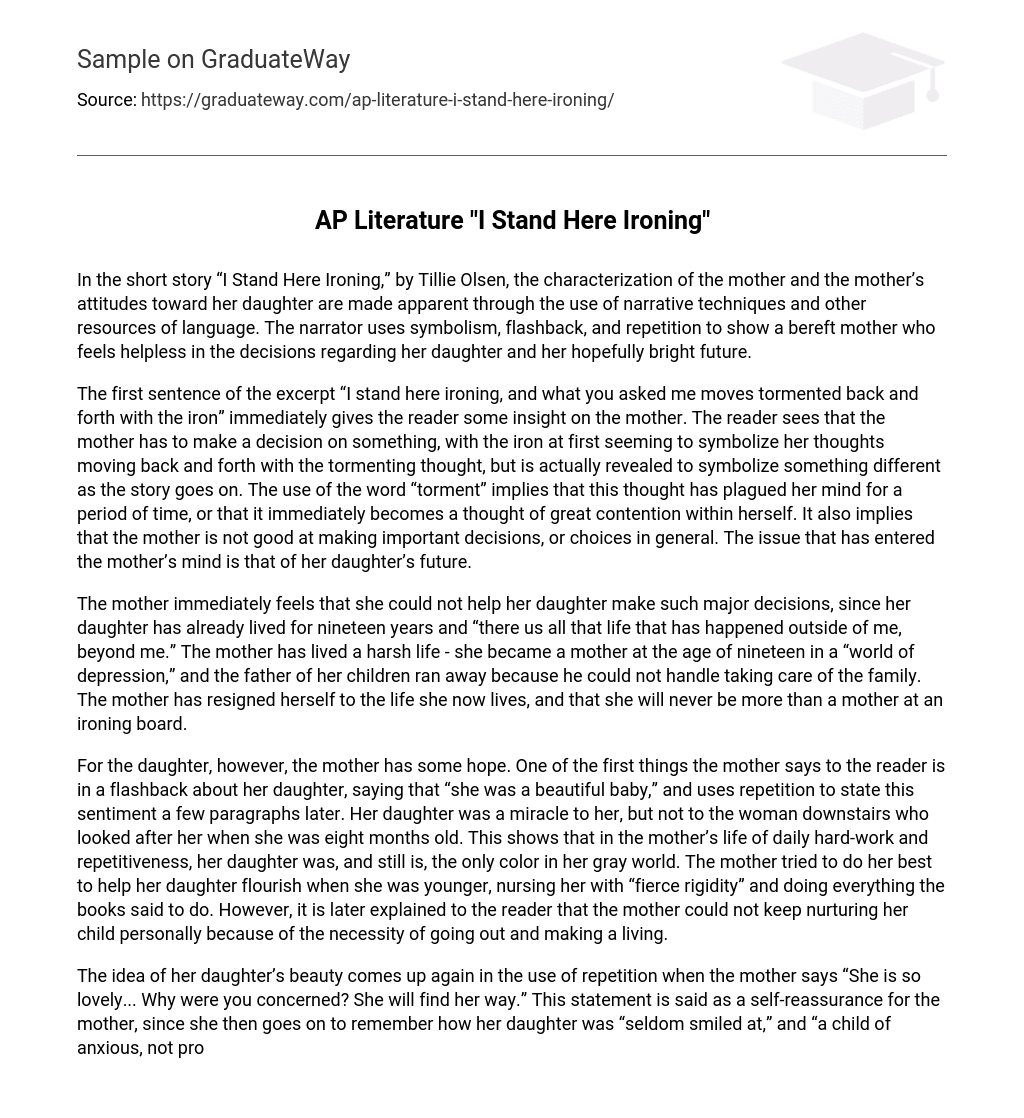In the short story “I Stand Here Ironing,” by Tillie Olsen, the characterization of the mother and the mother’s attitudes toward her daughter are made apparent through the use of narrative techniques and other resources of language. The narrator uses symbolism, flashback, and repetition to show a bereft mother who feels helpless in the decisions regarding her daughter and her hopefully bright future.
The first sentence of the excerpt “I stand here ironing, and what you asked me moves tormented back and forth with the iron” immediately gives the reader some insight on the mother. The reader sees that the mother has to make a decision on something, with the iron at first seeming to symbolize her thoughts moving back and forth with the tormenting thought, but is actually revealed to symbolize something different as the story goes on. The use of the word “torment” implies that this thought has plagued her mind for a period of time, or that it immediately becomes a thought of great contention within herself. It also implies that the mother is not good at making important decisions, or choices in general. The issue that has entered the mother’s mind is that of her daughter’s future.
The mother immediately feels that she could not help her daughter make such major decisions, since her daughter has already lived for nineteen years and “there us all that life that has happened outside of me, beyond me.” The mother has lived a harsh life – she became a mother at the age of nineteen in a “world of depression,” and the father of her children ran away because he could not handle taking care of the family. The mother has resigned herself to the life she now lives, and that she will never be more than a mother at an ironing board.
For the daughter, however, the mother has some hope. One of the first things the mother says to the reader is in a flashback about her daughter, saying that “she was a beautiful baby,” and uses repetition to state this sentiment a few paragraphs later. Her daughter was a miracle to her, but not to the woman downstairs who looked after her when she was eight months old. This shows that in the mother’s life of daily hard-work and repetitiveness, her daughter was, and still is, the only color in her gray world. The mother tried to do her best to help her daughter flourish when she was younger, nursing her with “fierce rigidity” and doing everything the books said to do. However, it is later explained to the reader that the mother could not keep nurturing her child personally because of the necessity of going out and making a living.
The idea of her daughter’s beauty comes up again in the use of repetition when the mother says “She is so lovely… Why were you concerned? She will find her way.” This statement is said as a self-reassurance for the mother, since she then goes on to remember how her daughter was “seldom smiled at,” and “a child of anxious, not proud, love.” The mother is aware that her daughter has not lived the happiest life possible, but still wants to believe that her daughter will do well in life, and have a better one than she did.
The only way the mother thinks she can help her daughter now is by helping her know “that she is more than this dress on the ironing board, helpless before the iron.” The narrator uses symbolism here again, except now the reader knows that the iron represents the harshness of life and how it can press a person if he succumbs to it, and the daughter is the beautiful article of clothing who is in danger of being pressed into a non-unique scrap in the closet. The mother wants her daughter to be able to make decisions about her own life, rather than the way the mother allowed her life to be led, letting the iron press her into a shape she was unable to change in the future.
The story “I Stand Here Ironing” by Tillie Olsen tells the tale of a mother and her daughter. The mother has let her life play out without making any attempts at changing it, and hopes her daughter will be different from her and take control of her own life. This sentiment was expressed through narrative techniques of symbolism, flashback, and repetition, and is one that many parents feel about their children.





